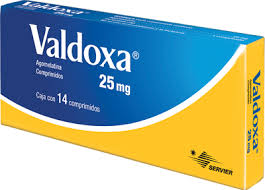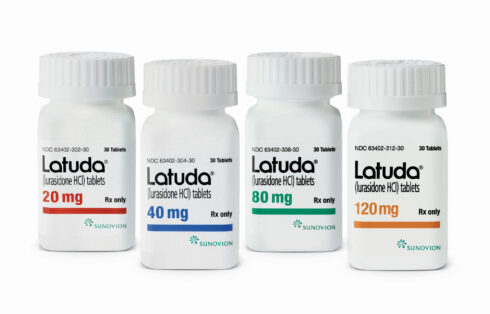Agomelatin = Valdoxan
1
AGOMELATINE
THERAPEUTICS
Brands • Valdoxan
see index for additional brand names
Generic? No
Class
• Neuroscience-based Nomenclature:
melatonin multi-modal (Mel-MM)
• Agonist at melatonergic 1 and melatonergic
2 receptors
• Antagonist at 5HT2C receptors
Commonly Prescribed for
(bold for FDA approved)
• Depression
How the Drug Works
• Actions at both melatonergic and 5HT2C
receptors may be synergistic and
increase norepinephrine and dopamine
neurotransmission in the prefrontal cortex;
may resynchronize circadian rhythms that
are disturbed in depression
• No influence on extracellular levels of
serotonin
How Long Until It Works
• Daytime functioning, anhedonia, and
sleep can improve from the first week of
treatment
• The onset of full therapeutic actions in
depression is usually not immediate, but
often delayed 2–4 weeks
• May continue to work for many years to
prevent relapse of symptoms
If It Works

• The goal of treatment is complete
remission of current symptoms as well as
prevention of future relapses
• Treatment most often reduces or even
eliminates symptoms, but not a cure since
symptoms can recur after medicine is
stopped
• Continue treatment until all symptoms are
gone (remission)
• Once symptoms gone, continue treating for
1 year for the first episode of depression
• For second and subsequent episodes of
depression, treatment may need to be
indefinite
If It Doesn’t Work
• Many patients have only a partial response
where some symptoms are improved but
others persist (especially insomnia, fatigue,
and problems concentrating)
• Other patients may be nonresponders,
sometimes called treatment-resistant or
treatment-refractory
• Consider increasing dose as early as
2 weeks after initiating treatment if
a response is insufficient (decision on dose
increase has to be balanced with a higher
risk of transaminase elevation; any dose
increase should be made on an individual
patient benefi t/risk basis and with strict
respect of liver function tests monitoring)
• Consider switching to another agent or
adding an appropriate augmenting agent
• Consider psychotherapy
• Consider evaluation for another diagnosis
or for a comorbid condition (e.g., medical
illness, substance abuse, etc.)
• Some patients may experience apparent
lack of consistent effi cacy due to activation
of latent or underlying bipolar disorder, and
require antidepressant discontinuation and
a switch to a mood stabilizer
Best Augmenting Combos
for Partial Response or
Treatment Resistance
• SSRIs (excluding fl uvoxamine), SNRIs,
bupropion, reboxetine, atomoxetine
(use combinations of antidepressant
with caution as this may activate bipolar
disorder and suicidal ideation)
• Modafi nil, especially for fatigue, sleepiness,
and lack of concentration
• Mood stabilizers or atypical antipsychotics
for bipolar depression, psychotic depression,
or treatment-resistant depression
• Benzodiazepines
Tests
• Liver function tests before initiation of
treatment and then after around 3 weeks,
6 weeks, 12 weeks, 24 weeks, and
thereafter when clinically indicated
• When increasing the dose, liver
function tests should be performed at
the same frequency as when initiating
treatment
• Liver function tests should be repeated
within 48 hours in any patient who
develops raised transaminases
Agomelatine.indd 1 gomelatine.indd 1 7/11/2017 4:05:56 PM /11/2017 4:05:56 PM
2
AGOMELATINE (continued)
augmentation strategies to treat side
effects
• Many side effects are time-dependent (i.e.,
they start immediately upon dosing and upon
each dose increase, but go away with time)
• Many side effects cannot be improved with
an augmenting agent
• Therotically activation and agitation may
represent the induction of a bipolar state,
especially a mixed dysphoric bipolar II
condition sometimes associated with
suicidal ideation, and require the addition
of lithium, a mood stabilizer or an atypical
antipsychotic, and/or discontinuation of
agomelatine (class warning)
SIDE EFFECTS
How Drug Causes Side Effects
• Adverse reactions usually mild to moderate
and occur within the fi rst 2 weeks of treatment
• Actions at melatonergic receptors and at
5HT2C receptors could contibute to the
side effects described below
Notable Side Effects
• Nausea and dizziness are most common
• Other adverse reactions are somnolence,
fatigue, insomnia, headache, anxiety,
diarrhea, constipation, upper abdominal
pain, vomiting, hyperhidrosis
• Increase of transaminase levels
Life-Threatening or
Dangerous Side Effects
✽ Rare hepatitis, hepatic failure
• Theoretically rare induction of mania (class
warning)
• Rare activation of suicidal ideation and
behavior (suicidality) (short-term studies
did not show an increase in the risk of
suicidality with antidepressants
compared to placebo beyond age 24)
(class warning)
Weight Gain
• Occurs in signifi cant minority
• Cases of weight decrease have been
reported
Sedation (Somnolence)
• Occurs in signifi cant minority
• Generally transient
• May be more likely to cause fatigue than
sedation
What to Do About Side Effects
• Wait
• Wait
• Stop if transaminase levels exceed 3 times
the upper limit of normal
• Switch to another drug
Best Augmenting Agents for Side
Effects
• Often best to try another antidepressant
monotherapy prior to resorting to
DOSING AND USE
Usual Dosage Range
• 25–50 mg/day at bedtime
Dosage Forms
• Tablet 25 mg
How to Dose
• Initial 25 mg/day at bedtime; after
2 weeks can increase to 50 mg/day
at bedtime
Dosing Tips
• If intolerable anxiety, insomnia, agitation,
akathisia, or activation occur either upon
dosing initiation or discontinuation,
consider the possibility of activated bipolar
disorder and switch to a mood stabilizer or
an atypical antipsychotic
Overdose
• Drowsiness and epigastralgia; fatigue,
agitation, anxiety, tension, dizziness,
cyanosis, or malaise have also been
reported
Long-Term Use
• Treatment up to 12 months has been found
to decrease rate of relapse
Habit Forming
• No
How to Stop
• No need to taper dose
Agomelatine.indd 2 gomelatine.indd 2 7/11/2017 4:05:56 PM /11/2017 4:05:56 PM
(continued) AGOMELATINE
3
Pharmacokinetics
• Half-life 1–2 hours
• Metabolized primarily by CYP450 1A2
Drug Interactions
• Use of agomelatine with potent CYP450
1A2 inhibitors (e.g., fl uvoxamine) is
contraindicated
• Tramadol increases the risk of seizures in
patients taking an antidepressant (class
warning)
Other Warnings/
Precautions
• Use with caution in patients with hepatic
injury risk factors, such as obesity/
overweight/non-alcoholic fatty liver disease,
diabetes, patients who drink large quantities
of alcohol and/or have alcohol use disorder,
or who take medication associated with risk
of hepatic injury. Doctors should ask their
patients if they have ever had liver problems.
• If symptoms or signs of potential liver
injury (dark urine, light-colored stools,
yellow skin/eyes, pain in upper right belly,
sustained new-onset and unexplained
fatigue) are present, agomelatine should be
discontinued immediately
• Use caution in patients with pre-treatment
elevated transaminases (> the upper limit
of the normal range and ≤ 3 times the
upper limit of the normal range)
• Discontinue treatment if serum
transaminases exceed 3 times the upper
limit of normal; liver function tests should
be performed regularly until serum
transaminases return to normal
• Agomelatine should be administered at
bedtime
• Use with caution in patients with bipolar
disorder unless treated with concomitant
mood-stabilizing agent
• When treating children off label (an
unapproved use), carefully weigh the
risks and benefi ts of pharmacological
treatment against the risks and benefi ts
of nontreatment with antidepressants and
make sure to document this in the patient’s
chart
• Warn patients and their caregivers about
the possibility of activating side effects
and advise them to report such symptoms
immediately
• Monitor patients for activation of suicidal
ideation, especially children and adolescents
Do Not Use
• If patient has hepatic impairment
• If patient has transaminase levels > 3 times
the upper limit of normal
• If patient is taking a potent CYP450 1A2
inhibitor (e.g., fl uvoxamine, ciprofl oxacin)
• If patient is taking an MAO inhibitor (MAOI)
• If patient has galactose intolerance, Lapp
lactase defi ciency, or glucose-galactose
malabsorption
• If there is a proven allergy to agomelatine
SPECIAL POPULATIONS
Renal Impairment
• Drug should be used with caution
Hepatic Impairment
• Contraindicated
Cardiac Impairment
• Dose adjustment not necessary
Elderly
• Effi cacy and safety have been established
(< 75 years old)
• Dose adjustment not necessary
• Should not be used in patients age
75 years and older
• Should not be used in elderly patients with
dementia
Children and Adolescents
• Carefully weigh the risks and benefi ts
of pharmacological treatment against
the risks and benefi ts of nontreatment
with antidepressants and make sure to
document this in the patient’s chart
• Monitor patients face-to-face regularly,
particularly during the fi rst several weeks
of treatment
• Safety and effi cacy have not been established
and it is not recommended
Pregnancy
• Controlled studies have not been
conducted in pregnant women
• Not generally recommended for use during
pregnancy, especially during fi rst trimester
Agomelatine.indd 3 gomelatine.indd 3 7/11/2017 4:05:58 PM /11/2017 4:05:58 PM
4
AGOMELATINE (continued)
Primary Target Symptoms
• Depressed mood, anhedonia
• Functioning
• Anxiety within depression
Pearls
• Agomelatine represents a novel approach to
depression through a novel pharmacologic
profi le, agonist at melatonergic MT1 /
MT2 receptors and antagonist at 5HT2C
receptors acting synergistically
• This synergy provides agomelatine with
a distinctive effi cacy profi le, different
from conventional antidepressants with
potentially an early and continuous
improvement over time
• Agomelatine improves anhedonia early in
treatment
• Improves anxiety in major depressive
disorder
• May be fewer withdrawals/discontinuations
for adverse events than with other
antidepressants
• No signifi cant effect on cardiac parameters
such as blood pressure and heart rate
• Some data suggest that agomelatine
may be specially effi cacious in achieving
functional remission
• Agomelatine may improve sleep quality
by promoting proper maintenance of
circadian rhythms underlying a normal
sleep-wake cycle
• Must weigh the risk of treatment (fi rst
trimester fetal development, third trimester
newborn delivery) to the child against
the risk of no treatment (recurrence
of depression, maternal health, infant
bonding) to the mother and child
• For many patients this may mean
continuing treatment during pregnancy
Breast Feeding
• Unknown if agomelatine is secreted in
human breast milk, but all psychotropics
assumed to be secreted in breast milk
• Therefore, breast feeding or drug needs to
be discontinued
• Immediate postpartum period is a high-risk
time for depression, especially in women
who have had prior depressive episodes,
so drug may need to be reinstituted late
in the third trimester or shortly after
childbirth to prevent a recurrence during
the postpartum period
THE ART OF PSYCHOPHARMACOLOGY
Potential Advantages
• Patients with lack of energy, anhedonia,
anxious comorbidity, and sleep-wake
disturbances
• Patients particularly concerned about
sexual side effects
Potential Disadvantages
• Patients with hepatic impairment
Agomelatine.indd 4 gomelatine.indd 4 7/11/2017 4:05:58 PM /11/2017 4:05:58 PM
(continued) AGOMELATINE
5
Suggested Reading
DeBodinat C , Guardiola-Lemaitre B , Mocaer
E , et al. Agomelatine, the fi rst melatonergic
antidepressant: discovery, characterization,
and development . Nat Rev Drug Discov
2010 ; 9 : 628 –42.
Goodwin GM , Emsley R , Rembry S , Rouillon F.
Agomelatine prevents relapse in patients with
major depressive disorder without evidence
of a discontinuation syndrome: a 24-week
randomized, double-blind, placebo-controlled
trial . J Clin Psychiatry 2009 ; 70 : 1128 –37.
Kennedy SH , Avedisova A , Belaïdi C ,
Picarel-Blanchot F , de Bodinat C . Sustained
effi cacy of agomelatine 10 mg, 25 mg, and
25–50 mg on depressive symptoms and
functional outcomes in patients with major
depressive disorder. A placebo-controlled
study over 6 months . Neuropsychopharmacol
2016 ; 26 (2): 378 –89.
Khoo AL, Zhou HJ, Teng M, et al. Network
meta-analysis and cost-effectiveness analysis
of new generation antidepressants. CNS Drugs
2015;29(8):695–712 .
Martinotti G , Sepede G , Gambi F , et al.
Agomelatine versus venlafaxine XR in the
treatment of anhedonia in major depressive
disorder: a pilot study . J Clin Psychopharmacol
2012 ; 32 (4): 487 –91.
Racagni G , Riva MA , Molteni R , et al. Mode
of action of agomelatine: synergy between
melatonergic and 5-HT2C receptors . World J
Biol Psychiatry 2011 ; 12 (8): 574 –87.
Stahl SM , Fava M , Trivedi M , et al. Agomelatine
in the treatment of major depressive disorder.
An 8 week, multicenter, randomized,
placebo-controlled trial . J Clin Psychiatry
2010 ; 71 (5): 616 –26.
Stahl SM . Mechanism of action of
agomelatine: a novel antidepressant exploiting
synergy between monoaminergic and
melatonergic properties . CNS Spectrums
2014 ; 19: 207 –12.
Stein DJ , Picarel-Blanchot F , Kennedy
SH. Effi cacy of the novel antidepressant
agomelatine on anxiety symptoms in
major depression . Hum Psychopharmacol
2013 ; 28 (2): 151 –9.
Taylor D , Sparshatt A , Varma S , Olofi njana O .
Antidepressant effi cacy of agomelatine: metaanalysis
of published and unpublished studies .
BMJ 2014 ; 348 : g2496.
Agomelatine.indd 5 gomelatine.indd 5 7/11/2017 4:05:58 PM /11/2017 4:05:58 PM
Agomelatine.indd 6 gomelatine.indd 6 7/11/2017 4:05:58 PM /11/2017 4:05:58 PM






